For long-duration outdoor roasts, you'll want robust spice blends that can withstand extended cooking times. Start with a 4:1 ratio of dominant to subtle spices, using salt and black pepper as your foundation. The Southwestern Desert Heat mix (brown sugar, smoked paprika, chili powder, garlic powder, kosher salt) works exceptionally well for grilled meats, while Mediterranean blends featuring oregano, thyme, and rosemary offer a sun-kissed alternative. Layer your spices strategically: add base notes early, primary spices during initial heat, and finish with lighter aromatics. Store your blends in airtight glass containers to maintain potency. These fundamental techniques just scratch the surface of mastering outdoor spice applications.
Essential Spice Blend Foundations
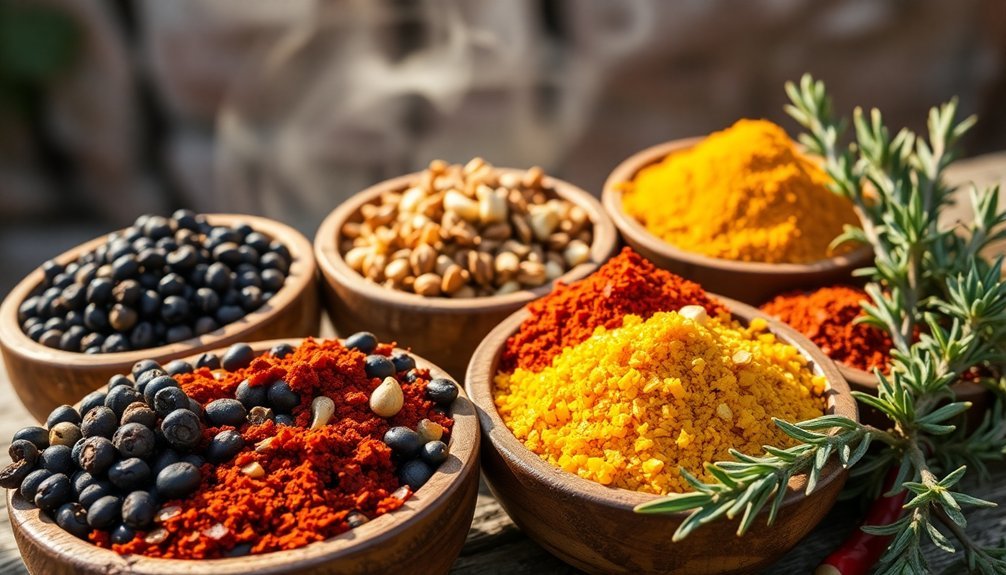
When creating your own spice blends for outdoor roasts, understanding the fundamental building blocks will elevate your cooking from basic to exceptional.
Start with salt and black pepper as your base, then layer in garlic and onion powder for depth. These foundational spices create a savory platform for more complex flavors. A well-stocked spice rack ensures you'll always have the essential ingredients needed for your blends.
You'll want to follow the 4:1 ratio rule – use four parts of your dominant flavors (like paprika or cumin) to one part of subtler spices (such as delicate herbs).
When combining spices, remember that coarse textures work best for roasts, as they'll gradually release their flavors during the long cooking process.
Store your blends in airtight containers away from heat to maintain their potency, and always opt for fresh, high-quality spices to guarantee maximum flavor impact.
Southwestern Desert Roasting Combinations
When you're ready to explore Southwestern flavors, you'll find three distinct spice combinations that capture the essence of desert cooking:
Desert Heat Spice Mix brings together cumin and chili powder for intense warmth.
Smoky Mesquite Blend combines smoked paprika with oregano for earthiness.
Cactus Flower Rub features a lighter touch with garlic powder and mild chile peppers.
These signature blends work particularly well with sweet potatoes, peppers, and corn, creating layers of authentic Southwest flavor that perfectly complement outdoor roasting.
For maximum nutrient retention, keep vegetables cut in uniform sized pieces when applying these spice blends.
You can easily customize each blend's heat level by adjusting the ratio of mild to spicy ingredients while maintaining their distinctive desert profiles.
Desert Heat Spice Mix
A fiery blend of Southwestern flavors, Desert Heat Spice Mix combines sweet, smoky, and spicy elements to create the perfect seasoning for outdoor roasting.
You'll need brown sugar, smoked paprika, chili powder, garlic powder, and kosher salt to craft this versatile blend.
Mix the ingredients thoroughly in a bowl, making sure to break up any brown sugar clumps. You can adjust the heat level by adding cayenne pepper to suit your taste.
Store your blend in an airtight container for future use.
This mix works wonderfully on grilled meats, especially chicken wings, ribs, and steaks. At only 25 calories per serving, it's a flavorful way to season without adding significant calories to your dishes.
You'll also love it on roasted vegetables, particularly sweet potatoes.
Drawing inspiration from Arizona, New Mexico, and Texas cuisines, it's a reliable choice for adding authentic Southwestern flair to your outdoor cooking.
Smoky Mesquite Blend
Building on the Southwestern theme, the Smoky Mesquite Blend takes desert flavors in a bold new direction. You'll find this versatile blend works exceptionally well with thick cuts of meat, adding depth through its combination of garlic powder, spices, and natural mesquite smoke flavoring. This robust blend can season up to 15lbs of your chosen meat when using the standard kit size.
| Meat Type | Flavor Impact | Best For |
|---|---|---|
| Dark Meats | Rich & Bold | Duck, Goose, Lamb |
| Red Meats | Deep & Smoky | Beef, Wild Game |
| Light Meats | Subtle & Complex | Fish, Poultry |
Don't limit yourself to just meats – this blend enhances everything from snack mixes to barbecue sauces. You'll want to use it sparingly as it packs a powerful punch. The blend maintains its potency for up to two years when stored properly in a cool, dry place.
Cactus Flower Rub
Deep in the heart of Southwestern cuisine, the Cactus Flower Rub captures the essence of desert flavors with its unique blend of aromatic spices and natural botanicals.
You'll find this versatile blend combines cactus flower extract's antioxidant properties with classic Southwestern spices like ancho chili powder, cumin, and smoked paprika.
To make the most of this rub, mix it with olive oil for a rich marinade or apply it directly to your meats before roasting.
It's particularly excellent on sweet potatoes and black bean dishes. You can customize the blend by adding chipotle powder for extra heat or oregano for an herbal note.
Whether you're roasting beef, pork, or vegetables, this rub delivers authentic Southwestern flair while letting you control the intensity of the desert-inspired seasonings.
Mediterranean Sun-Kissed Seasonings
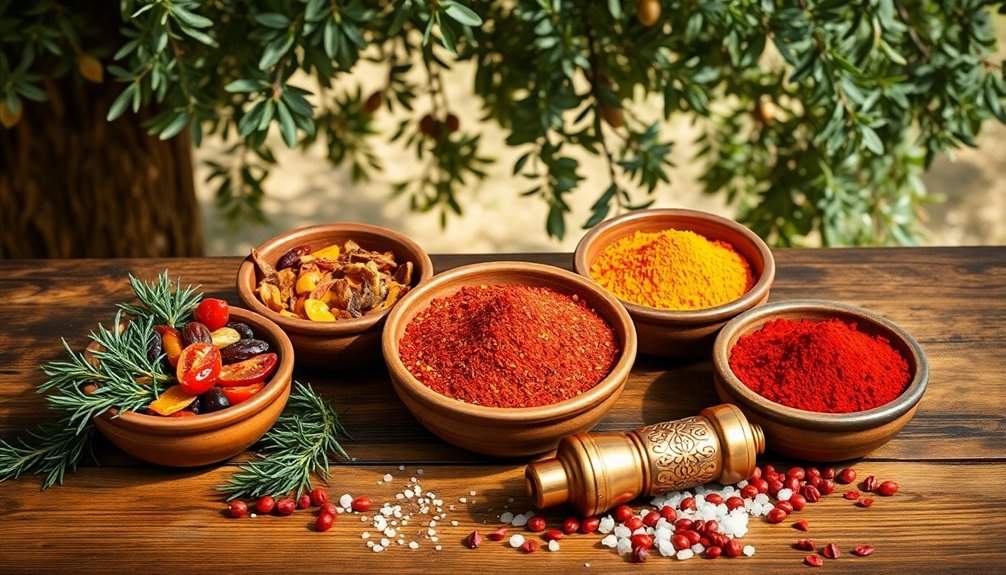
When Mediterranean cuisine calls for vibrant flavors, sun-kissed seasonings deliver an aromatic blend of herbs and spices that transport you straight to the coastal regions.
You'll find this versatile mix perfect for outdoor roasting, combining classic ingredients like oregano, thyme, basil, and rosemary with savory garlic and onion powder.
- Store your blend in an airtight container away from direct sunlight to maintain its potency for up to six months
- Toast whole seeds before grinding to intensify the flavors
- Adjust proportions to match your taste preferences – there's no strict rule
- Use it generously on meats, vegetables, or create marinades with yogurt and feta
For the best results, grind your spices just before use, and don't hesitate to experiment with optional additions like cumin or coriander to create your signature blend.
Slow Heat Infusion Methods
You'll want to release your spices' aromatic compounds gradually by using a heated oil infusion method at the lowest crockpot setting.
The ideal temperature range lets you extract flavors over 3-4 hours without scorching the delicate spices or burning the oil.
Low-Heat Aromatic Release
Successfully extracting the full flavor potential from spices requires mastering the art of low-heat aromatic release.
You'll need to focus on gentle heating techniques that preserve essential oils while maximizing aromatics. Dry roasting on low to medium heat allows spices like coriander and fennel to release their subtle flavors without burning, while toasting in fat helps build deeper flavor layers for your outdoor roasts.
- Start with whole spices like green cardamom and cinnamon, as they retain their oils better than pre-ground versions.
- Toast your spices gradually on low heat until they become fragrant and slightly smokey.
- Transfer immediately to a cool surface to prevent overcooking.
- Store your roasted spices in airtight glass containers to maintain their enhanced flavors.
Temperature Control Timing
Building upon proper aromatic release techniques, mastering temperature control timing takes your spice infusion to new heights.
You'll want to maintain temperatures between 100-110°F (38-43.3°C) for ideal results, using your body temperature as a reference point for safe infusion heat.
Set up your heat source – whether it's a slow cooker, double boiler, or stovetop – and monitor consistently. You can infuse for 30 minutes to 12 hours, depending on your desired intensity.
Keep herbs fully submerged in oil and stir regularly. Remove the lid to allow moisture evaporation during the process.
For precise control, use a probe thermometer and adjust your heat source accordingly. If you're using a double boiler, nest your glass container in a larger pot of water to maintain steady temperatures throughout the infusion process.
Solar Roasting Time Adjustments
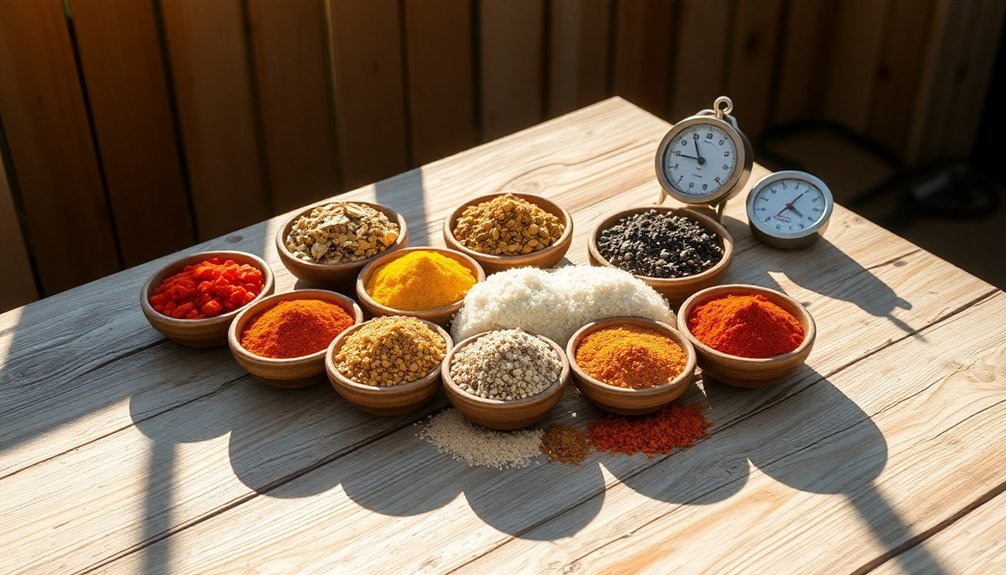
While solar roasting offers an eco-friendly cooking method, mastering the timing requires attention to several key factors.
You'll need to adjust your cooking schedule based on seasonal sun intensity and position throughout the day. For ideal results, you'll want to cook between 10:00 a.m. and 2:00 p.m. when the sun is strongest, and ascertain your cooker's shadow falls directly behind it.
- Preheat your solar oven for 30 minutes before adding food
- Face your cooker eastward for noontime meals and westward for evening dishes
- Stabilize your cooker with stones or bricks on windy days to maintain consistent heat
- Reorient your cooker every couple of hours during long cooking sessions
Remember to adjust cooking times during winter months, when you'll need steeper panel angles to capture more direct sunlight.
Layering Spices for Extended Cooking
Layering spices throughout extended cooking sessions creates deeper, more complex flavors that won't burn or become bitter. You'll want to build your flavors strategically, starting with a salt and pepper base to tenderize the meat before adding your primary spices. During the cook, introduce sweeter or savory elements gradually to prevent premature caramelization.
| Cooking Stage | Spice Application |
|---|---|
| Pre-Cook | Salt and pepper base |
| Initial Heat | Primary spice blend |
| Mid-Cook | Sweet or savory spices |
| Near Finish | Light flavor boost |
| Resting | Final seasoning dust |
For the best results, dry roast whole spices before applying them, and consider blooming some in oil to release their full potential. When smoking, adjust your spice layers based on your wood choice, as different smoke flavors interact uniquely with various seasonings.
Moisture Retention Spice Techniques
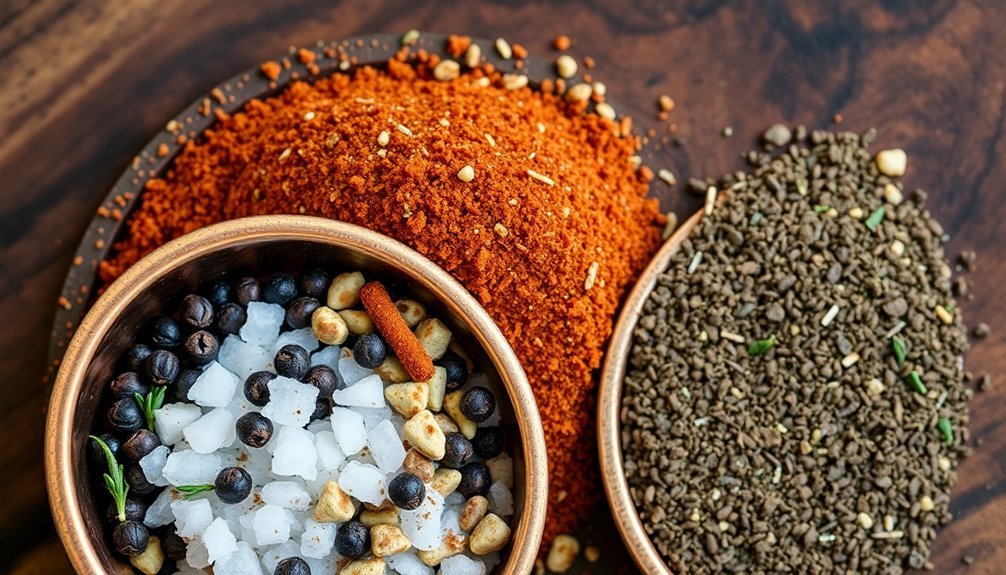
Managing moisture in your spice collection directly impacts the success of outdoor roasting.
You'll want to protect your seasonings from humidity while ensuring they retain their potent flavors for your outdoor cooking sessions. Start by storing your spice blends in airtight glass containers and keep them in a cool, dark pantry away from your grill or smoker area.
- Place a grain of rice in each spice container to absorb excess moisture and prevent clumping during humid outdoor cooking days.
- Use food-grade silica gel packs in your spice storage area for added moisture protection.
- Switch to containers with moisture-absorbing caps when storing frequently used grilling blends.
- Keep your spices in vacuum-sealed bags for bulk storage, transferring only what you'll need for each cooking session.
Heat-Reactive Seasoning Properties
Understanding how your spices react to different temperatures can transform your outdoor roasting experience, as heat triggers specific chemical reactions that release flavors at varying points during cooking.
You'll notice that some spices, like those containing essential oils, release their flavors quickly at high temperatures, while others need prolonged exposure to develop their full potential.
When planning your spice blend, consider timing the addition of heat-sensitive seasonings throughout the cooking process to create layers of flavor that build as your roast cooks.
Temperature-Controlled Flavor Release
When outdoor roasts meet high temperatures, a complex interplay of chemical reactions transforms your spice blend into deep, layered flavors.
You'll want to control these reactions carefully, as temperature affects both the timing and intensity of flavor release. The Maillard reaction creates rich, caramelized notes, while enzymatic processes from ingredients like garlic and ginger break down proteins for enhanced taste.
- Keep acidic spices like lemon and vinegar in balance – they'll affect both pH and reaction rates.
- Store your spices properly to prevent oxidation, which can diminish their potency.
- Add temperature-sensitive spices like nutmeg and cinnamon at strategic times to preserve their essential oils.
- Monitor your heat levels to optimize the Maillard reaction without burning the spices' delicate compounds.
Prolonged Heat Impact Analysis
The high-heat dynamics of outdoor roasting go beyond just flavor development – they directly affect your cooking surface's seasoning properties.
When you're cooking at high temperatures, you'll notice your seasoned surface reacting differently than it would at lower heats.
While intense heat can potentially break down some seasoning compounds, it's also working to strengthen your cooking surface. The high temperatures actually help create a more durable black magnetite layer instead of harmful red rust.
You'll get better heat distribution and retention as the seasoning fills the iron's pores through oxidation and polymerization.
To maintain these benefits during long roasts, you'll want to guarantee your surface is well-seasoned beforehand using oils that naturally harden, like tung or flaxseed oil.
This preparation helps protect your cookware while enhancing its heat-management capabilities.
Time-Based Spice Activation
Since spices react differently to heat exposure over time, mastering their activation points will dramatically improve your outdoor roasting results.
You'll notice these changes through the Maillard reaction, where amino acids and reducing sugars create complex flavors and that appealing brown color. As you roast, enzymatic reactions in spices like ginger and garlic will transform both texture and taste.
- Start with whole spices rather than ground ones – they'll release their flavors gradually and won't burn as quickly.
- Monitor pH changes as your spices heat up, as they'll affect both flavor development and food safety.
- Layer your spices strategically, adding heat-sensitive ones later in the cooking process.
- Use a heavy-bottom pan to maintain steady temperature control throughout the roasting session.
Traditional Native American Blends
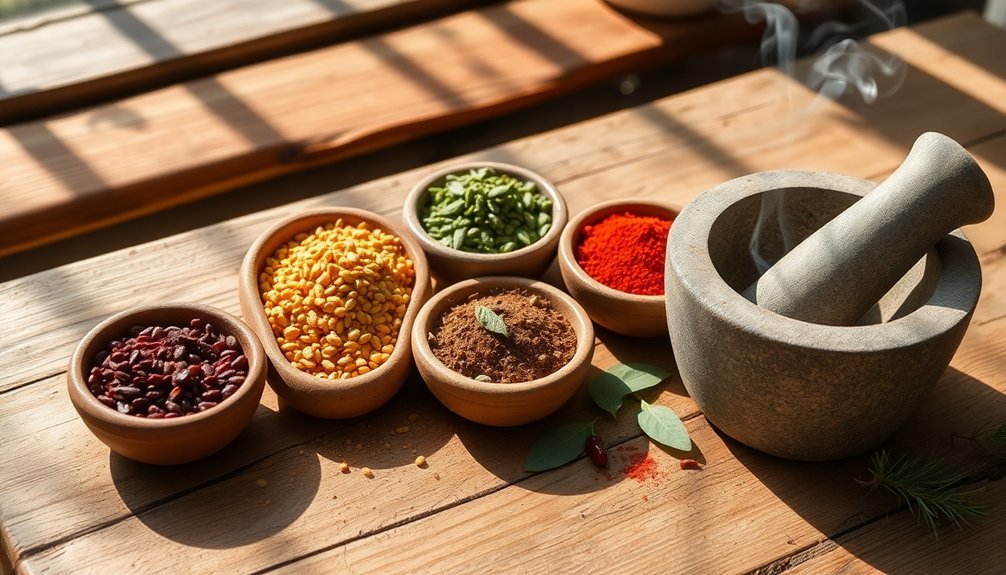
Native American spice blends reflect a rich heritage of combining locally foraged ingredients with traditional cultivation methods.
You'll find juniper berries, which offer a peppery-citrus flavor, prominently featured in many indigenous rubs, particularly in Wabanaki cuisine. These can be enhanced by toasting them alongside other whole spices.
To create an authentic blend, you'll want to incorporate sumac, a spice native to all 48 states, along with sage from the Southwest.
For heat, add traditional chile powders made from smoked jalapeños or dried poblanos. When you're preparing meat for outdoor roasting, combine these ground spices with kosher salt for a robust rub.
You can adapt your blend to reflect regional variations, whether you're focusing on Plains or Southwest flavors.
Optimal Spice Storage Solutions
Proper storage makes all the difference in preserving your spice blends' potency and flavor.
You'll want to keep your spices in airtight containers away from heat sources, direct sunlight, and steam-prone areas. For maximum freshness, store them in a cool, dry pantry or cabinet, and always use moisture-proof containers with tight seals.
- Choose glass jars with wide openings for whole spices, or opt for opaque containers to protect against light exposure.
- Label everything clearly with purchase dates and contents on both tops and sides.
- Organize your spices using drawer organizers or tiered risers for easy visibility.
- Remember that ground spices stay fresh for 6-10 months, while whole spices last up to two years.
For best results, grind whole spices just before use and rotate your stock regularly.
Fresh Versus Dried Considerations
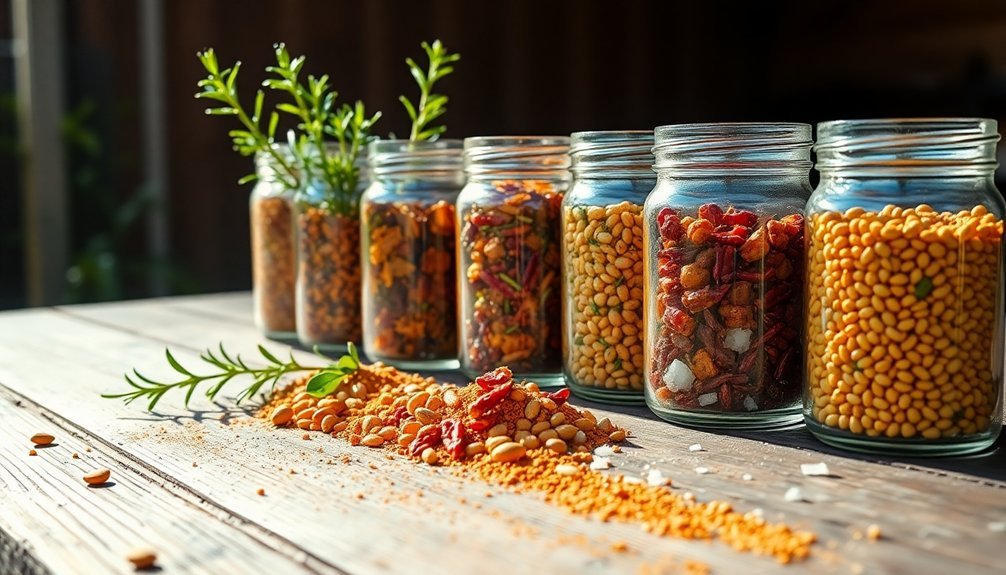
When creating spice blends for outdoor roasts, understanding the distinction between fresh and dried herbs can make or break your dish.
While dried herbs are more concentrated and better suited for long cooking times, you'll need to use 3-5 times more fresh herbs to achieve the same flavor intensity.
For outdoor roasting, you'll want to rely primarily on dried herbs in your spice blends. They're more heat-tolerant and maintain their flavor throughout extended cooking periods.
If you're using fresh herbs, add them towards the end of cooking to preserve their aromatic qualities. You can also create a balanced blend by combining dried spices for the base flavor with fresh herbs as finishing touches.
Remember to roast whole spices slowly for the best flavor development, and always let them cool before grinding.
Regional Solar Cooking Variations
Traditional spice blends from around the world have found new life in solar cooking, where their complex flavors develop beautifully during long, gentle heating periods.
You'll find that regional spices adapt perfectly to solar cooking methods, especially when you're working with slow-cooked meats and vegetables.
- Ethiopian berbere brings sweet and savory notes to solar-cooked stews, incorporating warming spices like ginger, cardamom, and cinnamon.
- Moroccan ras el hanout's 30+ ingredients create deep, complex flavors ideal for solar-cooked tagines.
- North African chermoula adds bright, herbal notes to fish and seafood dishes.
- Middle Eastern za'atar works wonderfully with vegetables and grains, offering lemony, herbal flavors.
For best results, you'll want to apply these spice blends before cooking, allowing the flavors to develop slowly in your solar cooker's consistent heat.
Aromatic Preservation During Roasting
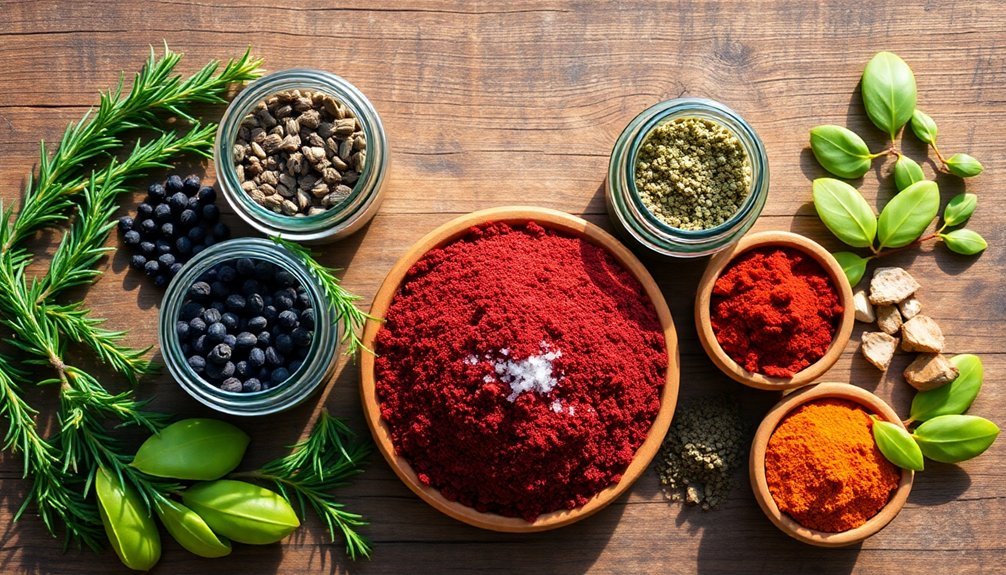
Maintaining the vibrant aromas of your spice blends during outdoor roasting requires careful timing and technique.
You'll want to layer your spices strategically to preserve their distinct characteristics throughout the cooking process.
Start by incorporating your base notes early in the roasting process, as these warm, neutral spices need time to develop depth.
Add middle notes like black pepper halfway through cooking to establish structure.
Save your bright top notes, such as coriander seeds and sumac, for the final stages to maintain their fresh, vibrant qualities.
When applying spices directly to hot surfaces, first add a small amount of water to prevent burning and enhance flavor release.
For maximum potency, grind your whole spices just before use, and remember to store any unused portions in airtight containers away from heat and light.
Frequently Asked Questions
Can I Substitute Smoked Paprika for Regular Paprika in Outdoor Roasts?
Yes, you can substitute smoked paprika for regular paprika in outdoor roasts. You'll get a deeper, smokier flavor that's perfect for roasted meats. Just use less smoked paprika since it's more intense.
How Do Altitude Changes Affect Spice Intensity During Long-Duration Roasting?
At higher altitudes, you'll notice spices extract more slowly but intensify over longer cooking periods. You'll need to reduce strong spices by 25% and monitor closely, as they'll concentrate during extended roasting times.
Which Spices Help Prevent Insects From Approaching Outdoor Roasting Setups?
You'll find that cinnamon, cloves, and chili powder are your best insect deterrents. Sprinkle them around your cooking area, and they'll naturally repel most pests while you're working outdoors.
Does Moon Phase Timing Affect Traditional Native American Spice Combinations?
No, you'll find that moon phases don't directly influence Native American spice combinations. While lunar cycles guide planting times and some herbal rituals, traditional spice blends are based on flavor profiles and culinary preferences.
Can Certain Spice Combinations Help Prevent Sunburn on Exposed Meat Surfaces?
Yes, you'll find that antioxidant-rich spices like turmeric, rosemary, and cayenne pepper can help protect exposed meat surfaces from sun damage. They'll work best when combined with healthy fats like ghee or duck fat.
In Summary
You'll find the art of long-duration outdoor roasting comes down to mastering your spice combinations and timing. Whether you're using Southwestern, Mediterranean, or regional blends, store your spices properly and adjust your cooking duration based on local solar conditions. Remember that dried spices work best for extended roasts, while fresh herbs should be added later to preserve their aromatic qualities.

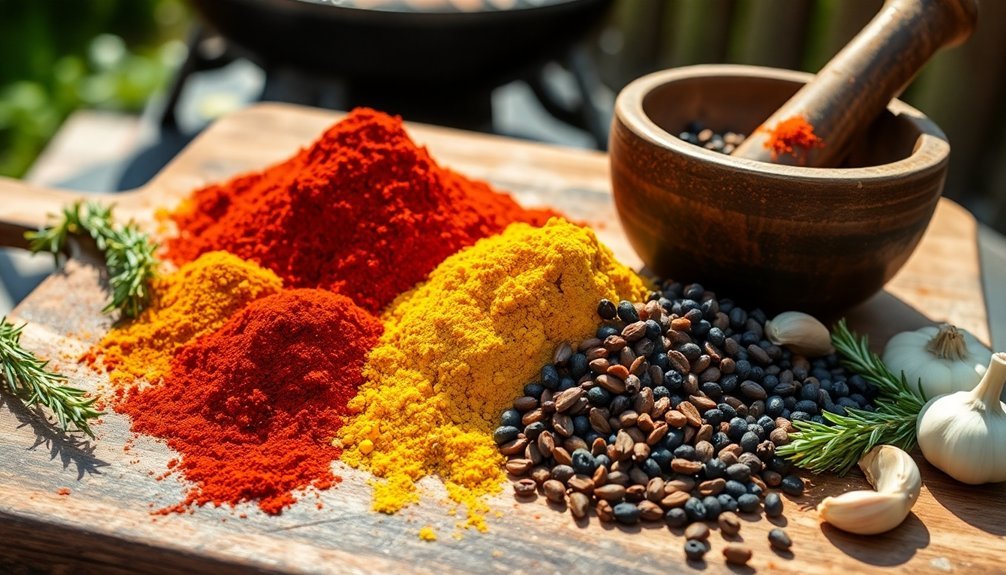



Leave a Reply